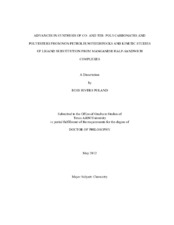| dc.description.abstract | This dissertation is written in two parts. The first pertains to polycarbonate and polyester synthesis using relatively benign processes.
The synthesis of polycarbonates from the coupling of CO2 and epoxides catalyzed by transition metal catalysts has long been studied in the DJD group. The benefits of this process are that it utilizes comparatively benign reagents, can be performed using no extraneous solvent, and is 100% atom efficient. A method potentially useful for achieving more desirable polycarbonate properties is to produce an epoxide A/epoxide B/CO2 terpolymer, thus allowing more fine "tuning" of properties to what one may desire while simultaneously influencing relative epoxide reactivity to potentially increase catalytic turnovers. Specifically, the coupling of propylene oxide and cyclohexene oxide with CO2 to yield a random copolymer with tunable properties has been studied via a Fineman-Ross analysis. Propylene oxide was found to be incorporated into the resultant polymer chain with anywhere from 4-10 times the preference of cylcohexene oxide.
Although it has been reported as early as 1969, the copolymerization of epoxides and cyclic anhydrides catalyzed by transition metal complexes to yield polyesters via a chain-growth mechanism has recently gained much attention. This robust method of polyester synthesis can utilize rather inexpensive reagents to synthesize an array of polyester products which have a wide range of Tg values (-30 degrees C ? 90 degreesC), achievable through simple monomer selection.
The second part of this dissertation deals with the kinetic study of ligand substitution from manganese carbonyl metal fragments. Some time ago it was postulated that complexes of the (Cp)M(CO)2L variety undergo ligand substitution via a associative mechanism allowed by a haptotropic eta5-eta3 shift in the eta5 ligand. Through kinetic studies and theoretical modeling, an approximate activation energy barrier of ~34 kJ/mol has been calculated for the ring slip of (2,5-dimethylpyrrole)Mn to occur. Additionally, further kinetic studies were performed in which Tp, a ligand electronically similar to Cp, was compared to MnCp complexes. | en |


